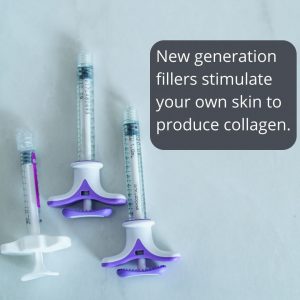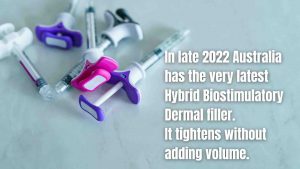Hyaluronic Acid
| Best used:AM or PM
| Caution:Well tolerated by many | Best for: Moisturiser, sensitive skin |
| Comments: Best under not on the skin | Mode of action: Humectant | Science Score: ***** (Dermal Fillers)
|
What is the science behind hyaluronic acid?
This miracle molecule is composed of ‘sugar molecules’ known as polysaccharides. Hyaluronic acids (referred to as HAs)is a naturally occurring ingredient found in skin, bones, joints & eyes. It helps keep skin taut & youthful, & acts as a lubricant in the joints. This skin care ingredient is in the form of gels, lotions, creams, masks, tablets, capsules & of course injectables.
Hyaluronic acid can draw moisture from the environment to keep your skin moist, holding almost 1000 times its own weight in water. Hence it is not only a moisturizer, it has the ability to hold extra moisture. Found in the dermal layers of skin, HAs maintain skin integrity, reducing wrinkles & provides structural support.
What can hyaluronic acid do for my skin?
Due to their super water binding capacity, hyaluronic acid plays a key role in retaining skin moisture, making it an extraordinarily powerful humectant. This ingredient can benefit your skin care routine in the following ways-
- Fast acting moisturizer that retains water & reduces water loss.
- Anti Wrinkle effects by reducing fine lines.
- Vehicle for other skin care ingredients such as vitamin A, B, C. The benign nature of this molecule allows it to be mixed with many other skin care products.
- Instant anti-aging effects. There is no other ingredient that can give instant effects with zero downtime. To date this is the most effective molecule in adding dermal & hypodermal volume, with the least amount of downtime.
- Flexibility with use. HAs can be used as a stand alone moisturizer, found in serums, creams & lotions. HAs can also be delivered in a mask, or a part of a mesotherapy procedure, such as with the Aquagold Facial. HAs can also be injected into various depths, including the dermis, hypodermis & even on top of bone. There is no other skin care ingredient that has the flexibility of hyaluronic acid.
* As a procedural dermatologist hyaluronic acid is by far the most commonly prescribed ingredient in my practice. My preferred method of delivery? Injectables. To gain an understanding of what hyaluronic acid can do for your skin, visit the Dermal Filler section of this website.
What is the best Hyaluronic Acid to use- serums, creams or…?
Injectables aside, hyaluronic acid can be delivered in serum (most popular), creams, gels, washes & masks. Maximum concentration is between 1 to 2%, any higher and water can be pulled from the deeper layers. Most serums contain varying molecular sizes of hyaluronic acid as this allows different depths of penetration. Cross linking (much like in dermal fillers), means that HAs last longer in the epidermis. Even with this increased penetration & stability, HAs are readily broken down by the enzyme hyaluronidase within 16 to 48 hours.

View our Treatment Gallery
Who should use hyaluronic acid?
Everyone. Hyaluronic acid can be used in so many ways, from simple serums, creams, lotions through to dermally delivered HAs. The ideal formulation will depend on your age, skin type, concerns & goals. Simple serums can provide ample skin hydration, whilst hyaluronic acid masks can give you a boost of water, & make your skin care products work harder.
Dermal volume can be enhanced for people in their 30s and beyond through the use of hyaluronic acid fillers, whilst the cautious of you may want to try HA mesotherapy with the use of Aqua Gold Microfillers.
What we know is that parabens bind weakly to estrogen receptors, in the order of magnitude of around 1/4000 th capacity of estrogen itself, & that this experiment was in rats. In the context of breast cancer, there is no good evidence to suggest that there is a causative effect as no controls were conducted. At the time of writing (2022), there is no evidence that parabens are harmful in the context of malignant potential, this differs from sensation potential in higher risk individuals (even then it is low).
How to use hyaluronic acid?
Apply the product of choice to your area of concern. Simple as that. Unlike other skin care ingredients such as retinol, retinoic, ascorbic, lactic, glycolic & citric acids, you do not require a test patch with hyaluronic acid, as this ingredient is well tolerated by just about everyone (exception is if you use serum on broken skin). Just dive right into it.
Office treatments such as Hydrafacial, Tixel, microneedling & lasers enhance the penetration of hyaluronic acid into the deeper layers of your skin. The flipside is that HAs will also speed up skin recovery from these procedures, so it is a win-win for your skin.


What works well with hyaluronic acid?
Just about every skin care active, including retinol, niacinamide, ascorbic acid, pigment correctors, antioxidants & skin acids. Because HAs are a naturally occuring compound, they can be safely mixed with other ingredients.

Do you need to moisturise after applying hyaluronic acid?
Complex answer as it depends on the environmental humidity. Using an emollient after Hyaluronic Acid will seal in the moisture and also provide moisture for the HA to absorb, should the air around you be dry.
What is sodium hyaluronate?
Sodium hyaluronate is a hyaluronic acid derivative (salt). It has a lower molecular weight, which allows it to penetrate the deeper layers of the skin. Hyaluronic acid is a big molecule and if not formulated well, it may just sit on the skin’s surface. Even with a smaller molecule, hyaluronic acid still remains in the epidermis as it is unable to penetrate the basement membrane.
Which is better, hyaluronic acid or retinol?
Retinol is an incredible ingredient to speed up cell regeneration, reduce pigment & boost collagen. Hyaluronic acid helps draw water into the skin providing intense hydration. In fact dermatologists recommend using both retinoids & hyaluronic acids as the latter can reduce unwanted retinoid induced side effects such as drying, stinging & skin irritation.

Prescription retinoids.
Can you use it under your eyes?
Absolutely, as this is a natural molecule it is super gentle on the delicate skin of the undereye area. This is a common ingredient of eye cream, along with peptides, caffeine, & vitamin K. Best applied at night, hyaluronic acid can refresh your eyes over night as you sleep.

Why are hyaluronic acid injections infinitely better than HA creams & serums?
Because hyaluronic acid belongs under your skin, and not on top! Your skin’s natural reservoir of hyaluronic acid lines under the skin, in the deeper dermal layers. Creams, gels, & serums deliver hyaluronic acid to the upper epidermis. The molecule itself is much too large to pass through the skin’s natural sieve called the basement membrane.
Injectables, namely dermal fillers, place hyaluronic acids in the deeper layers of the skin. Injectors use different size hyaluronic acid molecules that have various degrees of cross linking. Each subtype of HA will have unique properties to optimise delivery. Some HAs are viscous & hold shape. These are used as ‘foundation’ fillers to provide structure & volume. Other hyaluronic acids have a more fluid consistency, allowing them to be placed superficially, such as around the eyes.

If you really pay attention to the ‘before & afters’ you will see that hyaluronic acid delivered via injectables really do give results, whilst you will not see any ‘before & afters’ with hyaluronic acid serums, creams or lotions.
What is the best concentration of hyaluronic acid?
Between 1-2%. Any higher and HAs can actually draw water out of the lower depths of your epidermis.
What are the side effects of hyaluronic acid?
In the context of topical based HAs, they have virtually zero long term side effects as hyaluronic acid is a naturally occurring molecule. The caveat is the theoretical risk of skin dehydration if the environmental humidity is low. In humid environments HAs pull moisture from the air, while in low humidity (think winter or AC rooms) a theoretical gradient exists which may extract moisture from the deeper layers of the skin. A simple emollient over the top can prevent this from happening.
What foods are high in hyaluronic acid?
HAs are found in many food sources. In the context of collagen & hyaluronic acid rich foods the highest concentrations are found in animal bones, tendons, skin & the yucky bits of internal organs. If you are into consuming the entire animal, knock yourself out- otherwise there are things called hyaluronic acid serums & dermal fillers. If you would like to know more regarding dietary collagen and HA supplements including bioavailability, book a consultation with a dietician.
Are hyaluronic acid supplements good?
Hyaluronic acid & collagen supplements are best for joint symptoms such as osteoarthritis. They have been studied in detail for over two decades. Collagen & hyaluronic acid supplementation for skin has not had much success, however they are harmless.
How do I incorporate Hyaluronic Acid in my daily skin care routine?
A sensible skin care routine that involving hyaluronic acid goes something like this;
AM: Cleanser, SPF, Make up, with the option of antioxidants (Ferulic acid, Ascorbic Acid, Tocopherol)
PM: Cleanser, Hyaluronic Acid, Retinol or Niacinamide – Ascorbic Acid, AHAs or pigment correctors
*There are many formulations of Hyaluronic Acid including masks, gels, serum, creams, lotions. HAs are added to many different types of topicals.
Davin’s Viewpoint on Hyaluronic Acid
Probably the most flexible ingredient & the biggest plus for the aesthetic industry in the entire history of man, and woman-kind. There is no other ingredient (this includes retinoic acid, deep peels, & sunscreen) that has such a dramatic impact on skin with virtually zero downtime as compared to hyaluronic acids. Retinoids are plagued with side effects such as dryness, flaky & sensitive skin, sunscreens prevent (so in reality you do not see the effects), deep peels with chemicals such as phenol croton oil make a huge difference, however the downtime exceeds two weeks. The use of hyaluronic acid dermal fillers has revolutionised the skin industry. HAs not on provide volume, they displace skin, & can enhance your own fibroblasts to produce innate collagen.
There are very little if any negatives with topical use as HAs are immunologically banal, meaning skin allergies are almost unheard of. If you are allergic to HAs it is more than likely due to the preservatives and or the vehicle. HAs can also enhance delivery of key ingredients such as retinoic acid, ascorbic acid, antioxidants & others by improving skin hydration. Dermatologists often employ the old fashioned, but highly effective method of ‘wet wraps’, namely to hydrate the epidermis after application of the chosen active. HA does this job, meaning improved transepidermal delivery of drugs such as retinoic acid.
The absolute rate limiting factor with HAs is to find ways to deliver this large molecule through the skin’s gateway, known as the basement membrane. To date, even the smallest HAs can not penetrate through this barrier, hence why injections or mesotherapy is more effective than just topical application.
Biostimulator is a new novel dermal filler released in 2022 (Australia). Biostimulator main point of difference is that it is biostimulatory, hence it uses your own immune system to stimulate collagen & adipocytes or fat cells. Think of it as a hyaluronic acid booster or accelerator for your skin. Each session takes 5 minutes to perform. Recommended 2 sessions, 4 weeks apart.
The future looks promising for the skin care ingredient of the century, and beyond.

